Abstract
The hydrological model ECOMAG was used to calculate runoff characteristics in the main arctic (Northern Dvina and Pechora) and southern (Don and Kuban) river basins of Eastern Europe using the data from the ensemble of global climate models under the scenario of 1.5 and 2 °C global warming in the 21st century relative to pre-industrial values. Flow generation models were calibrated and validated based on runoff measurements at gauging stations using meteorological observation data. According to the results of numerical experiments, the relative change in river runoff in European Russia increases from north to south and from east to west under global warming of 1.5 to 2 °C. As a result, hydrological systems in milder climate were found to be more vulnerable to climate change. The assessment of flow anomalies in European Russia under the selected climate scenarios revealed the following general features: winter runoff in arctic rivers would increase, spring melt runoff in the Northern Dvina and Don would decrease, and summer–autumn runoff in all studied rivers would decrease to varying degrees. The most negative runoff anomalies are characterized in the southwestern part of the Northern Dvina basin, the middle part of the Don basin, and the lowland part of the Kuban basin, whereas positive runoff anomalies are characterized in the northern and eastern parts of the Pechora basin. Global warming of 1.5 to 2 °C would have the greatest impact on the rate of reduction of Kuban summer–autumn runoff and Don runoff during the spring flood, as well as the increase in Northern Dvina and Pechora winter runoff.
1. Introduction
Climate change has had a significant impact in recent decades in European Russia, primarily on the intra-annual distribution of runoff. The findings of such analyses can be found in the works of Lomonosov Moscow State University [1,2], the Russian Academy of Sciences’ Institute of Water Problems and Institute of Geography [3,4,5], the State Hydrological Institute [6,7], and others. A summary of the changes in river flow in Russia is presented in a review article [8]. Since the 1980s, winter flow in the Don basin river has increased by 30–120% [4,5,9]. It has been established that the snow water equivalent is decreasing by the beginning of spring, resulting in a decrease in spring flooding. Thus, spring runoff in rivers in central European Russia decreased by 10–30% [8]. Summer–autumn runoff is increasing in European Russia’s forest-steppe and steppe zones, which are characterized by high spatial variability [2]. In general, seasonal variability in runoff is associated with earlier and more prolonged floods, an increase in winter runoff due to winter thaws caused by humid and warm air invasion, and an early transition of air temperatures to positive values. Natural river flow regulation (reduction of intra-annual fluctuations) in the Don basin has increased by an average of 30% over the last four decades [1]. Simultaneously, a weak positive trend in annual runoff was observed for rivers in northern European Russia, with no statistically significant changes in the intra-annual distribution of runoff and maximum discharge [8]. Rivers in the Kuban basin that receive a large share of rainfall runoff are experiencing an increase in the frequency of dangerous flooding caused by heavy precipitation. However, a decrease in July–August runoff has been observed in the Kuban basin as a whole over the last few decades due to a decrease in the glacial component [10].
The current estimates of future changes in the flow of the studied rivers, determined using various hydrological models and data from the ensemble of global climate models (GCMs), are shown below. Their number is severely constrained by the absence of process-based runoff generation models for the Don and Kuban basins, as well as by the only recent work for the Pechora basin. The Northern Dvina is the most studied of the rivers under consideration in terms of assessing changes in the future water regime. According to the results of the SWIM model calculations, the flow of the Northern Dvina may increase by 5–15% in the 21st century under various RCP scenarios [11]. The SWAP model produced similar results, increasing the flow of the Northern Dvina by 5–10% [12], whereas the ECOMAG model, which is based on Russian databases of the land surface parameters, predicts that changes in the annual flow in the 21st century will be close to zero with significant intra-annual transformation [13]. Estimates of water regime changes for the Don basin were obtained using water-balance hydrological models with ten-day and monthly calculation steps [5]. Thus, depending on the scenario, the annual flow of the Don would not exceed 5% until the 2030s. The review of publications revealed a lack of estimates of possible changes in the flow of the Pechora and Kuban in the 21st century.
Methods for assessing changes in the water regime of large rivers using physically based spatially distributed hydrological models and GCMs have been developed in recent years [14,15,16]. When solving the tasks of long-term forecasting of water regime changes, the application of hydrological models of this class operating on a daily time step allows for sufficient detail assessment of the physical mechanisms of river basin response to climatic impacts, taking into account regional characteristics and reducing uncertainties of river flow change estimates.
In 2018, a special report [17] was published with the main goal of determining the negative impacts of 1.5 and 2 °C (targets presented in the Paris Agreement on Climate Change) global warming above pre-industrial values on natural and social systems on a global scale. Such studies almost entirely exclude European Russia, confirming the critical importance and relevance of obtaining new physically based results of assessment of hydrological consequences of 1.5 and 2 °C global warming in the 21st century based on the synthesis of detailed hydrological process models of runoff generation and GCMs ensemble within large river basins of the Northern Dvina, Pechora, Don, and Kuban. Because the hydrological models for the four river basins use the same data sources for land surface parameters and meteorological variability, a more reliable comparative analysis of river water regime change calculation results is possible.
2. Data and Methods
2.1. Study River Basins
The study focuses on two rivers from the Arctic basin (Northern Dvina and Pechora) and two rivers from the Mediterranean basin that flow into the Sea of Azov (Don and Kuban) (Figure 1). The catchment area of the Northern Dvina River at the outlet gauge Ust-Pinega is 348,000 km2 (Table 1). The water regime is characterized by spring floods, summer and winter low-water periods, and autumn rain floods. The duration of the period with negative air temperature is 5.5 months. Solid and liquid precipitation are 33% and 67%, respectively. The runoff coefficient of the Northern Dvina River is 0.49. The catchment area of the Pechora at the outlet gauge Oksino is 312,000 km2. The water regime is characterized by spring floods, winter low-water periods, and summer and autumn rain floods. The duration of the period with negative air temperature is almost 7 months. Solid and liquid precipitation are 43% and 57%, respectively. The runoff coefficient of the Pechora River is 0.82.
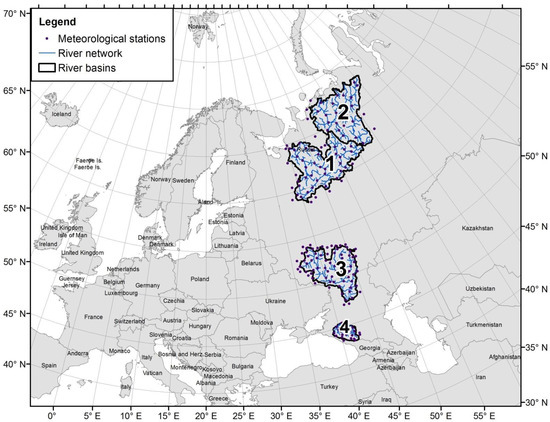
Figure 1.
Location of the studied river basins: 1: Northern Dvina—Ust-Pinega, 2: Pechora—Oksino, 3: Don—Belyaevsky, 4: Kuban—above the Krasnodar reservoir.

Table 1.
Main hydrometeorological characteristics of the four studied catchments.
The catchment area of the Don is 422,000 km2 and at the Belyaevsky gauge is 204,000 km2. The water regime is characterized by spring floods and low water during other periods. The duration of the period with negative air temperature is 4 months. Solid and liquid precipitation are 25% and 75%, respectively. The runoff coefficient of the Don River is 0.14. The catchment area of the Kuban is 57,900 km2 and at the gauge above the Krasnodar reservoir is 34,000 km2. The water regime is characterized by spring–summer snow and glacial meltwater floods and by high rainfall floods. The duration of the period with negative air temperature is 2.5 months. Solid and liquid precipitation are 16% and 84%, respectively. The runoff coefficient of the Kuban River is 0.24.
2.2. Runoff Generation Models
The ECOMAG-based [18] models of flow formation in the basins of the Northern Dvina, Pechora, Don, and Kuban rivers were used to study changes in the water regime, which had previously been used for large rivers in Europe, Asia and Northern America [19,20,21,22,23], as well as in mountain rivers [24,25,26]. This model makes it possible to calculate the spatial distribution of the processes of snow cover and snowmelt formation; soil freezing and thawing; vertical heat and moisture transport in frozen and unfrozen soil; evapotranspiration; surface, subsurface and groundwater flow; and streamflow transformation in the channel system. Modeling of hydrological processes at each elementary watershed is performed for four levels: the topsoil layer, horizon of caliche, groundwater and prechannel flow. During the cold season, snow cover is added. A more detailed mathematical description of the flow generation processes in the ECOMAG model is presented in [27].
The analysis of the publications revealed that for the first time, hydrological spatially distributed models on the daily time step for the Don and Kuban basins were developed and verified. There are analogs of flow formation models for the Northern Dvina and Pechora [11,12,13] and detailed flow formation models based on finite element methods for a small part of the Kuban and Don catchments [28,29]. The four river basin models are based on unified sources of information about the land surface and the variability of meteorological characteristics. This approach enables a more reliable comparative analysis of the results of river water regime change calculations.
The channel network and river basins were schematized by dividing them into elementary watersheds using a digital relief model with a spatial resolution of 1 km. The number of elementary river watersheds in the Don basin is 129, the Northern Dvina is 198, the Pechora is 174, and the Kuban is 31. The spatially distributed parameters of the models were determined using the Global Harmonized World Soil and the Global Land Cover Characterization databases. Long-term series of daily values of surface air temperature and humidity, as well as precipitation, measured at a network of meteorological stations, were used as model boundary conditions. For the Don River basin, observational data from 75 meteorological stations were used, 50 stations for the Northern Dvina River basin, 30 stations for the Pechora River basin, and 21 stations for the Kuban River basin. For model calibration, a multiyear series of daily discharge at gauging stations was prepared. Model calibration was performed for the Don basin’s Belyaevsky gauge, which determines 95% of water inflow to the Tsimlyansk reservoir and is considered as the outlet gauge. Ust-Pinega is the outlet gauge to the Northern Dvina basin, and Oksino is the outlet gauge to the Pechora basin. The Kuban basin’s flow formation model was calibrated for the gauge near the Krasnodar reservoir. The efficiency of modeling daily flow was assessed using the NSE, KGE, and BIAS criteria. The better the calculation quality, the closer the NSE and KGE are to one and the closer BIAS is to zero.
2.3. Hydrological Modeling Based on GCMs Data
To reduce existing uncertainties and to improve the accuracy and spatial and temporal resolution of climate projections for European Russia, a database of daily meteorological information required for hydrological models was created using grid data from the CMIP5 (Coupled Model Intercomparison Project 5) GCMs from the ISIMIP (Inter-Sectoral Impact Model Intercomparison Project). These data represent the surface fields of meteorological characteristics interpolated on a regular 0.5° latitude–longitude grid (downscaling), and a procedure was performed using ERA family reanalysis data to eliminate model systematic errors of intra-annual meteorological variation (bias correction) [30]. According to the observational data, the GCMs GFDL-ESM2M and MIROC5 reproduced the global air temperature dynamics most accurately for the period 1861–2005 [31].
The possibilities of reproducing annual and seasonal river runoff for the baseline period of 1970–1999 were investigated using flow formation models and GCMs grid data to calculate the ensemble of multiyear hydrographs of daily runoff. Annual and seasonal flow rates, high (Q10—probability of exceeding 10% days per year) and low (Q90—probability of exceeding 90% days per year) runoff (based on flow duration curves), and runoff coefficient were calculated from GCMs data and were compared to those obtained earlier by modeling from meteorological station observations. The division of runoff by season was as follows: winter runoff of the Northern Dvina, Don, and Kuban from November to March, and of the Pechora from November to April; spring flood of the Northern Dvina from April to June, of the Pechora from May to June, and of the Don and Kuban from April to May; summer and autumn runoff of the Northern Dvina and Pechora from July to October, and of the Don and Kuban from June to October. Furthermore, the modeling results were used to compare calculations of runoff-forming factors such as snow water equivalent and the depth of seasonal freezing of soils on average for the basin based on data from meteorological stations and GCMs.
Global climate change projections based on four RCP scenarios (RCP 2.6, RCP 4.5, RCP 6.0, and RCP 8.5) were used in calculations for the future period until the end of the 21st century. A 30-year moving average was used to determine the periods for reaching global warming thresholds of 1.5 and 2 °C relative to pre-industrial values for each GCM and RCP. The results of the calculations (with a daily time step and spatial resolution equal to the size of the elementary catchments) for the 1.5 and 2 °C threshold values were then averaged. According to the data used, the average global warming will be 1.5 °C by 2045 and 2 °C by 2064 [32]. Anomalies of climatic and hydrological characteristics of the studied rivers are calculated as the ratio of the calculated value for global warming conditions at 1.5 and 2 °C to the corresponding value determined from GCM data for the baseline period 1970–1999 (Figure 2).
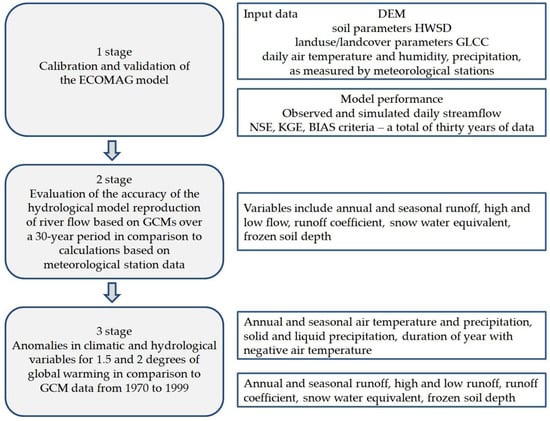
Figure 2.
Flowchart outlining the stages of this research.
3. Results and Discussion
3.1. Validation of Runoff Generation Models
Manual calibration of model parameters was carried out in the Northern Dvina, Pechora, and Don basins from 1985 to 1999 and in the Kuban basin from 1989 to 1995 (Table 2). Model validation was carried out using independent measurement data from the Northern Dvina, Pechora, and Don basins from 2000 to 2014 and the Kuban basin from 1996 to 2002. The NSE values for the studied rivers range from 0.62 to 0.91, the KGE from 0.68 to 0.94, and the BIAS within 12%. The robustness of models is noted during the transition from the calibration to validation periods.

Table 2.
Values of statistical criteria of the simulated daily flow in the basins of the Volga, Don, Northern Dvina, Pechora and Kuban rivers for the period of model calibration and validation.
The dynamics of the Northern Dvina, Pechora, Don, and Kuban annual runoff are presented in Figure 3. The correlation coefficient for the annual flow of the Northern Dvina was 0.86, for the Pechora was 0.84, for the Don was 0.68, and for the Kuban was 0.87. The flow duration curves of the observed and simulated daily runoff of the Northern Dvina, Pechora, Don, and Kuban are shown in Figure 4. Simulated values of high flow in the Northern Dvina and Kuban (below 5% exceedance probability), and Pechora (below 10% exceedance probability), and low flow in the Don (above 70% exceedance probability) and Kuban (above 80% exceedance probability) are underestimated relative to observed flow, while the model slightly overestimates the Don flow in the 20–40% exceedance probability range. The criterion ratio of the mean square error of the model to the mean square deviation of the observed runoff for the Northern Dvina flow duration curve was 0.13, for the Pechora 0.14, for the Don 0.21, and for the Kuban 0.17, indicating that all values were less than 0.5, which is optimal.
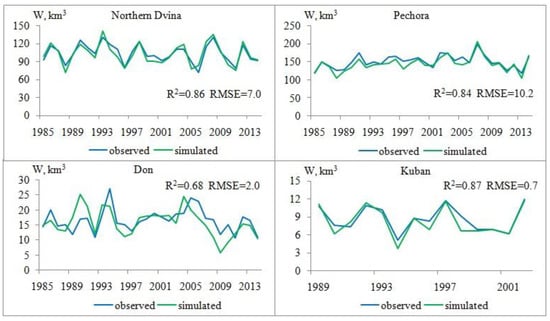
Figure 3.
Dynamics of the simulated and observed annual flow of the Northern Dvina, Pechora, Don for the period 1985–2014 and Kuban for the period 1989–2002.
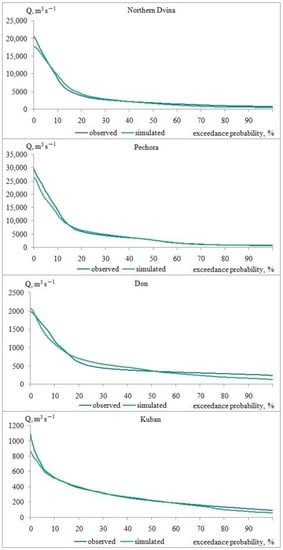
Figure 4.
Flow duration curves of the observed and simulated daily runoff of the Northern Dvina, Pechora, Don and Kuban rivers.
Figure 5 shows the monthly flow rates of the Northern Dvina, Pechora, Don, and Kuban rivers calculated using a runoff formation model based on GCM ensemble data and meteorological station observations from 1970 to 1999. In comparison to calculations based on meteorological station data, hydrological models using GCMs data reproduce annual runoff in the gauges with BIAS of less than 4%. At the same time, BIAS in winter runoff calculation ranges from 1% (Kuban) to 16% (Don), in spring flood runoff from 3% (Northern Dvina) to 15% (Kuban), and in summer–autumn runoff from 1% (Kuban) to 19% (Pechora). When evaluating the accuracy of high (Q10) and low (Q90) runoff calculations using GCMs, BIAS for high runoff was 1–10%, and BIAS for low runoff was 2–16%, with the highest values for the Don and Kuban, which can be explained by the small absolute values of runoff in comparison to the arctic rivers. The rivers’ runoff coefficients are quite accurately reproduced: the error was 0.01 for the Don and Pechora, 0.02 for the Northern Dvina, and 0.04 for the Kuban.
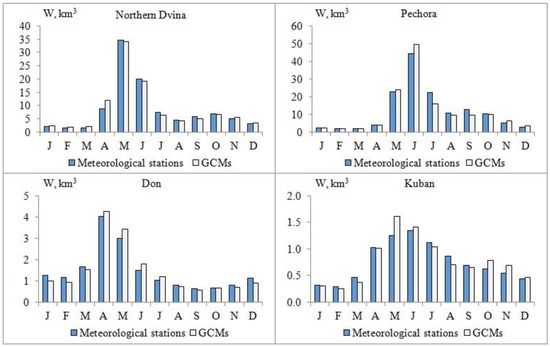
Figure 5.
Monthly runoff rates of the Northern Dvina, Pechora, Don and Kuban calculated using runoff formation models based on GCMs data and meteorological station observations for the period 1970–1999.
3.2. Meteorological Projections
According to our calculations, the rate of rising air temperature in general increases from the south to the north of European Russia as a result of global warming. The estimated increase in mean annual air temperature in the Northern Dvina and Pechora basins under 1.5 °C global warming would be 2.8 °C, in the Don basin 2.5 °C, and in the Kuban basin 1.9 °C compared to the baseline period of 1970–1999 (Figure 6). The estimated increase in mean annual air temperature in the Pechora basin under 2 °C global warming would be 4.1 °C, in the Northern Dvina basin 3.7 °C, in the Don basin 3.4 °C, and in the Kuban basin 2.7 °C. To compare the several river basins, the seasons were divided as follows: winter from November to March, spring from April to May, and summer–autumn from June to October. At the same time, the Northern Dvina and Pechora basins would show the greatest estimated rate of warming during winter, by 3.1–4.3 and 3.8–5.5 °C, respectively, the Don for spring, by 3–4 and 3.6–4.8 °C, and the Kuban for summer–autumn, by 2.3–3.2 °C. An increase in global air temperature of 1.5 to 2 °C would cause estimated additional warming in the studied river basins by 0.8–1.3 °C per year and by 0.6–1.7 °C by season.
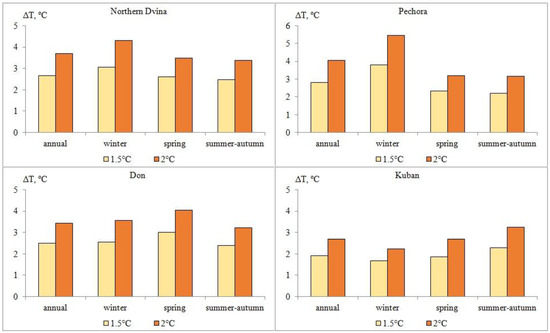
Figure 6.
Anomalies of mean annual and seasonal air temperature in the Northern Dvina, Pechora, Don and Kuban basins under global warming of 1.5 and 2 °C in the 21st century relative to the baseline period 1970–1999.
Estimated annual precipitation would increase by 11–15% for the Pechora, 4–8% for the Don and Northern Dvina, and close to zero for the Kuban (Figure 7). The greatest increase in estimated precipitation would occur during the winter season in each river basin, ranging from 6–9% on the Don to 15–19% on the Pechora. The estimated relative increase in summer–autumn precipitation in the Pechora basin would be 9–13%, 4% in the Northern Dvina and Don basins, and 8–16% in the Kuban basin. An increase in global air temperature from 1.5 to 2 °C would cause estimated additional moistening of the Northern Dvina and Pechora basins by 3–4.5% but decreased moistening of the Kuban basin by 4% due to the warm season and almost no change in the Don basin.
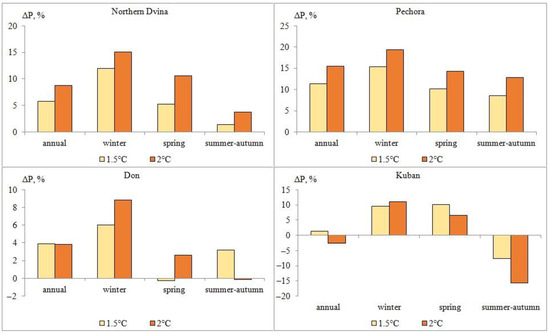
Figure 7.
Anomalies of mean annual and seasonal precipitation in the Northern Dvina, Pechora, Don and Kuban basins under global warming of 1.5 and 2 °C in the 21st century relative to the baseline period 1970–1999.
Under 1.5 °C global warming, the estimated duration of the year with negative air temperature would decrease in the Northern Dvina and Pechora basins by 2.5 and 4 weeks, respectively, and in the Don and Kuban basins by 3 and 5 weeks. There would be almost no change in solid precipitation in the Northern Dvina and Pechora basins and a decrease of 7–14% in the Don and 17–29% in the Kuban under 1.5 and 2 °C global warming, respectively. The estimated increase in liquid precipitation in the Kuban basin would be less than 5%, 10% in the Don basin, 8–15% in the Northern Dvina, and 18–29% in Pechora.
3.3. Hydrological Projections
Under 1.5 to 2 °C of global warming, the estimated annual flow of the Northern Dvina would decrease by 11%, the Don by 21–24%, the Kuban by 9–22%, and the Pechora will increase by 5–7% (Figure 8). At the same time, the picture of estimated seasonal flow changes is rather mixed: a significant increase in winter runoff of the Northern Dvina (30–50%) and the Pechora (50–80%), with weak variability for the Don and Kuban rivers, a decrease in spring runoff of the Northern Dvina (10–15%) and Don (30–40%), with weak variability for the Pechora and Kuban, and a decrease in summer–autumn runoff of the Northern Dvina and Don (35–40%), the Pechora (8–13%) and Kuban (25–45%).
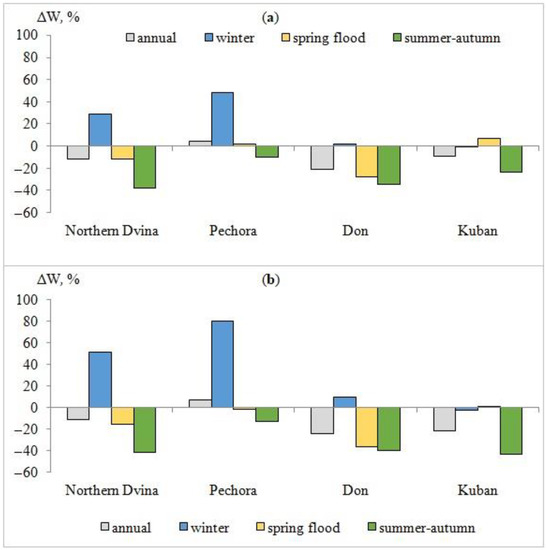
Figure 8.
Anomalies of annual and seasonal runoff of the Northern Dvina, Pechora, Don and Kuban under global warming of 1.5 °C (a) and 2 °C (b) in the 21st century relative to the period 1970–1999.
The reduction in annual runoff of the Kuban River is largely in the summer–autumn period and is explained by a significant decrease in precipitation and the component of glacial meltwater. In the Don, this effect is seen in reduced runoff during the spring flood. The rate of increase in winter runoff of the Northern Dvina and Pechora is due to an increased period of thaws. Thaws in the arctic river basins during the cold season of November to March will undoubtedly affect runoff, but they will not be in the middle of winter, as is the case, for example, in the Don basin, but at the beginning or end of this period. Winter has the highest estimated rate of warming in the Northern Dvina and Pechora basins for both scenarios. Given that the seasonal boundaries were fixed at the monthly level in the seasonal change analysis, there is a situation where with such intense warming, the spring flood is shifted to earlier months, and the estimated increase in winter flow is partly related to this: in the Northern Dvina the winter period is from November to March and in the Pechora winter period, it is from November to April. Furthermore, the arctic rivers experienced an estimated relative increase in summer–autumn precipitation, which contributes to increased estimated channel storage and groundwater capacity at the start of the cold season. The relative changes in winter runoff are smaller in the southern basins because there has already been a significant increase over the historical period, in contrast to the arctic rivers, where this process is expected to develop more and more actively, even though changes in winter runoff are actually not large in absolute values relative to the annual runoff of the arctic rivers.
Under 1.5 and 2 °C global warming, the average maximum snow water equivalent is estimated to decrease by 24–32% in the Don basin, 14–20% in the Kuban basin, 7–14% in the Northern Dvina basin, and 2–7% in the Pechora basin (Figure 9). The average depth of seasonal freezing of soils would decrease by 10 cm in the Northern Dvina and Kuban basins and by 10–20 cm in the Pechora and Don basins as a result of warming.

Figure 9.
Anomalies of snow water equivalent (SWE) and the soil freezing depth (Hf) in the Northern Dvina, Pechora, Don and Kuban basins under global warming of 1.5 and 2 °C in the 21st century relative to the baseline period 1970–1999.
Under both global warming scenarios, anomalies in seasonal flow redistribution reduce the high flow (Q10) of the Northern Dvina by 11–13%, the Kuban by 10–20%, and the Don by 23–27%, with the Pechora remaining unchanged (Figure 10). The Kuban has the greatest contrast between global warming scenarios. The low flow (Q90) of the Northern Dvina would increase by 15–20%, the Pechora by 10–30%, and the Don by 15–25% with increasing values under intensified warming (Figure 10). The opposite effect is observed for the Kuban River’s low flow: a 12% estimated increase under 1.5 °C global warming and a 12% decrease under 2 °C global warming. The runoff coefficient of the Northern Dvina would decrease by 0.09–0.1, the Pechora by 0.05–0.06, the Don by 0.03–0.04, and the Kuban by 0.03–0.06 (Figure 11). Despite an increase in precipitation, evaporation would be expected to play a larger role in the water balance of the studied river basins. The indicated trends of future water regime changes in the Don river basin would be generally similar to the estimates obtained for the Volga River’s left-bank tributaries [22], and changes in the water regime of northern European Russia’s rivers would be similar to changes in the Kama river basin [32,33]. According to [34], positive anomalies in annual runoff are possible in most of Russia in the 21st century, while negative anomalies are possible in the south of European Russia (basins of the Don, Kuban, Terek, etc.). Maximum flow during snowmelt may be reduced by 10–30% in southwestern Russia [35], which agrees with the findings of this study. According to [11,12], using different hydrological models, the annual runoff of the Northern Dvina in the future will increase by 5–15% without detailing by season, whereas our calculations show a 10% decrease, primarily due to a reduction in summer–autumn runoff. The reasons for the disparity in estimates of changes in the Northern Dvina’s future flow are as follows: different GCMs, different hydrological models (ECOMAG, SWIM, SWAP), referencing to different periods of the 21st century (middle, end), and RCPs, whereas this study is based on reaching the global warming threshold, and all RCPs are considered equally probable.
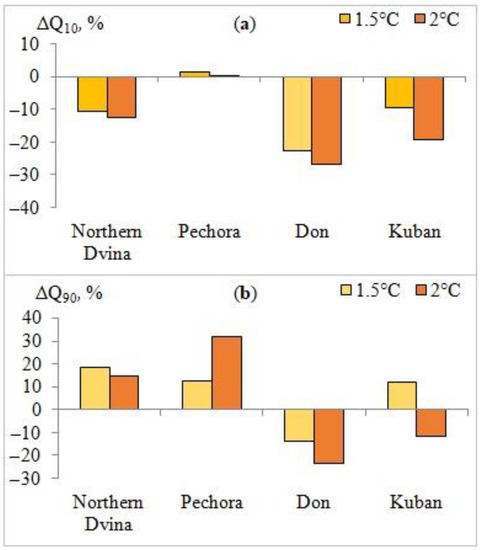
Figure 10.
High (a) and low (b) flow anomalies of the Northern Dvina, Pechora, Don and Kuban under global warming of 1.5 and 2 °C in the 21st century relative to the period 1970–1999.
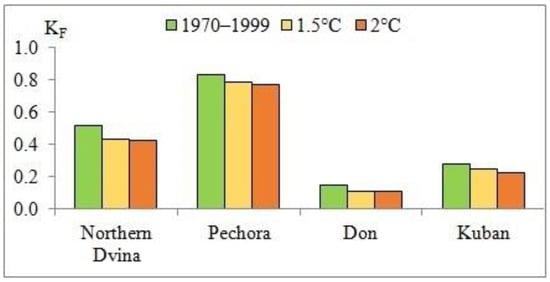
Figure 11.
Runoff coefficient (KF) of the Northern Dvina, Pechora, Don, and Kuban rivers for the baseline period 1970–1999 and under global warming of 1.5 and 2 °C in the 21st century.
4. Conclusions
In general, with a 1.5 to 2 °C global warming, the values of the relative change in annual flow of rivers in European Russia increase from north to south and from east to west, indicating that hydrological systems in milder climates were more sensitive to changes in meteorological characteristics. The most negative runoff anomalies are characterized in the southwestern part of the Northern Dvina basin, the middle part of the Don basin, and the lowland part of the Kuban basin, whereas positive runoff anomalies are characterized in the northern and eastern parts of the Pechora basin.
The assessment of flow anomalies in European Russia revealed the following general features: winter runoff of arctic rivers would increase, spring melt runoff of the Northern Dvina and Don would decrease, and summer–autumn runoff of all studied rivers would decrease to varying degrees. The change in annual flow of the Pechora river would be positive, while the change in flow of the Northern Dvina, Don, and Kuban rivers would be negative. Given the current process of natural regulation of the flow of rivers in European Russia’s forest zone [1] and its predicted strengthening in the future for all of the studied rivers except for the Pechora, there will be an additional need to adapt the current rules of flow regulation by the Tsimlyansk and Krasnodar reservoirs in the Don and Kuban basins. Water resources will become increasingly scarce in the Don and Kuban basins. The further direction of refinement of the obtained results of the global warming impact on water regime changes in European Russia river basins could be the use of meteorological projections from the CMIP6 and land use dynamics during the 21st century.
Funding
This research was funded by the Russian Science Foundation (project 20-77-00077—calculation of changes in the flow of the Northern Dvina, Pechora, Don and Kuban rivers) and the Governmental Order to Water Problems Institute, Russian Academy of Sciences (subject no. FMWZ-2022-0001—spatial and temporal analysis of changes in the water regime of rivers).
Institutional Review Board Statement
Not applicable.
Informed Consent Statement
Not applicable.
Data Availability Statement
The GCM output data are available on the ISIMIP server (data link https://www.isimip.org/gettingstarted/input-data-bias-correction/, accessed on 1 April 2023).
Acknowledgments
The author is grateful to the ISIMIP for the GCM output data used for hydrological modeling.
Conflicts of Interest
The author declares no conflict of interest.
References
- Frolova, N.; Agafonova, S.; Kireeva, M.; Povalishnikova, E.; Pakhomova, O. Recent Changes of Annual Flow Distribution of the Volga Basin Rivers. Geogr. Environ. Sustain. 2017, 10, 28–39. [Google Scholar] [CrossRef]
- Kireeva, M.; Frolova, N.; Rets, E.; Samsonov, T.; Entin, A.; Kharlamov, M.; Telegina, E.; Povalishnikova, E. Evaluating Climate and Water Regime Transformation in the European Part of Russia Using Observation and Reanalysis Data for the 1945-2015 Period. Int. J. River Basin Manag. 2020, 18, 491–502. [Google Scholar] [CrossRef]
- Bolgov, M.; Korobkina, E.; Trubetskova, M.; Filimonova, M.; Filippova, I. Present-Dey Variations of the Minimum Runoff of the Volga Basin Rivers. Russ. Meteorol. Hydrol. 2014, 39, 187–194. [Google Scholar] [CrossRef]
- Dzhamalov, R.; Frolova, N.; Telegina, E. Winter Runoff Variations in European Russia. Water Resour. 2015, 42, 758–765. [Google Scholar] [CrossRef]
- Geordiadi, A.G.; Milyukova, I.P.; Kashutina, E.A. Contemporary and Scenario Changes in River Runoff in the Don Basin. Water Resour. 2020, 47, 913–923. [Google Scholar] [CrossRef]
- Georgievskii, V.; Grek, E.; Grek, E.; Lobanova, A.; Molchanova, T. Spatiotemporal Changes in Extreme Runoff Characteristics for the Volga Basin Rivers. Russ. Meteorol. Hydrol. 2018, 43, 633–638. [Google Scholar] [CrossRef]
- Kalyuzhnyi, I.; Lavrov, S. Variability of Frost Depth in the Volga River Basin and Its Impact on Runoff Formation in Winter and Spring under Climate Change. Russ. Meteorol. Hydrol. 2016, 41, 487–496. [Google Scholar] [CrossRef]
- Frolova, N.L.; Magritskii, D.V.; Kireeva, M.B.; Grigor’ev, V.Y.; Gelfan, A.N.; Sazonov, A.A.; Shevchenko, A.I. Streamflow of Russian Rivers under Current and Forecasted Climate Changes: A Review of Publications. 1. Assessment of Changes in the Water Regime of Russian Rivers by Observation Data. Water Resour. 2022, 49, 333–350. [Google Scholar] [CrossRef]
- Kireeva, M.; Frolova, N.; Winde, F.; Dzhamalov, R.; Rets, E.; Povalishnikova, E.; Pakhomova, O. Low Flow on the Rivers of the European Part of Russia and Its Hazards. Geogr. Environ. Sustain. 2016, 9, 33–47. [Google Scholar] [CrossRef]
- Rets, E.P.; Durmanov, I.N.; Kireeva, M.B.; Smirnov, A.M.; Popovnin, V.V. Past ‘Peak Water’ in the North Caucasus: Deglaciation Drives a Reduction in Glacial Runoff Impacting Summer River Runoff and Peak Discharges. Clim. Chang. 2020, 163, 2135–2151. [Google Scholar] [CrossRef]
- Lobanova, A.; Liersch, S.; Nunes, J.P.; Didovets, I.; Stagl, J.; Huang, S.; Koch, H.; Rivas López, M.D.R.; Maule, C.F.; Hattermann, F.; et al. Hydrological Impacts of Moderate and High-End Climate Change across European River Basins. J. Hydrol. Region. Stud. 2018, 18, 15–30. [Google Scholar] [CrossRef]
- Nasonova, O.N.; Gusev, Y.M.; Kovalev, E.E.; Ayzel, G.V.; Panysheva, K.M. Projecting Changes in Russian Northern River Runoff Due to Possible Climate Change during the 21st Century: A Case Study of the Northern Dvina, Taz and Indigirka Rivers. Water Resour. 2019, 46, S145–S154. [Google Scholar] [CrossRef]
- Krylenko, I.; Motovilov, Y.; Antokhina, E.; Zhuk, V.; Surkova, G. Physically-Based Distributed Modelling of River Runoff under Changing Climate Conditions. Proc. IAHS 2015, 368, 156–161. [Google Scholar] [CrossRef]
- Gelfan, A.; Kalugin, A.; Krylenko, I.; Nasonova, O.; Gusev, Y.; Kovalev, E. Does a Successful Comprehensive Evaluation Increase Confidence in a Hydrological Model Intended for Climate Impact Assessment? Clim. Chang. 2020, 163, 1165–1185. [Google Scholar] [CrossRef]
- Gelfan, A.N.; Gusev, E.M.; Kalugin, A.S.; Krylenko, I.N.; Motovilov, Y.G.; Nasonova, O.N.; Millionshchikova, T.D.; Frolova, N.L. Runoff of Russian Rivers under Current and Projected Climate Change: A Review 2. Climate Change Impact on the Water Regime of Russian Rivers in the XXI Century. Water Resour. 2022, 49, 351–365. [Google Scholar] [CrossRef]
- Krysanova, V.; Hattermann, F. Intercomparison of Climate Change Impacts in 12 Large River Basins: Overview of Methods and Summary of Results. Clim. Chang. 2017, 141, 363–379. [Google Scholar] [CrossRef]
- Masson-Delmotte, V.; Zhai, P.; Pörtner, H.; Roberts, D.; Skea, J.; Shukla, P.; Pirani, A.; Moufouma-Okia, W.; Péan, C.; Pidcock, R.; et al. Global Warming of 1.5 °C. An IPCC Special Report on the Impacts of Global Warming of 1.5°C above Pre-Industrial Levels and Related Global Greenhouse Gas Emission Pathways, in the Context of Strengthening the Global Response to the Threat of Climate Change, Sustainable Development, and Efforts to Eradicate Poverty; Cambridge University Press: Cambridge, UK, 2018; p. 616. [Google Scholar]
- Motovilov, Y.; Gottschalk, L.; Engeland, K.; Rodhe, A. Validation of a Distributed Hydrological Model against Spatial Observations. Agricult. For. Meteorol. 1999, 98, 257–277. [Google Scholar] [CrossRef]
- Gel’fan, A.; Kalugin, A.; Krylenko, I.; Nasonova, O.; Gusev, E.; Kovalev, E. Testing a Hydrological Model to Evaluate Climate Change Impact on River Runoff. Russ. Meteorol. Hydrol. 2020, 45, 353–359. [Google Scholar] [CrossRef]
- Kalugin, A. Climate Change Attribution in the Lena and Selenga River Runoff: An Evaluation Based on the Earth System and Regional Hydrological Models. Water 2022, 14, 118. [Google Scholar] [CrossRef]
- Kalugin, A. Future Climate-Driven Runoff Change in the Large River Basins in Eastern Siberia and the Far East Using Process-Based Hydrological Models. Water 2022, 14, 609. [Google Scholar] [CrossRef]
- Kalugin, A. The Impact of Climate Change on Surface, Subsurface and Groundwater Flow: A Case Study of the Oka River (European Russia). Water Resour. 2019, 46, S31–S39. [Google Scholar] [CrossRef]
- Kalugin, A.; Motovilov, Y. Runoff Formation Model for the Amur River Basin. Water Resour. 2018, 45, 149–159. [Google Scholar] [CrossRef]
- Bugaets, A.; Gartsman, B.; Gelfan, A.; Motovilov, Y.; Sokolov, O.; Gonchukov, L.; Kalugin, A.; Moreido, V.; Suchilina, Z.; Fingert, E. The Integrated System of Hydrological Forecasting in the Ussuri River Basin Based on the ECOMAG Model. Geosciences 2018, 8, 5. [Google Scholar] [CrossRef]
- Kalugin, A. Process-Based Modeling of the High Flow of a Semi-Mountain River under Current and Future Climatic Conditions: A Case Study of the Iya River (Eastern Siberia). Water 2021, 13, 1042. [Google Scholar] [CrossRef]
- Kornilova, E.; Krylenko, I.; Rets, E.; Motovilov, Y.; Bogachenko, E.; Krylenko, I.; Petrakov, D. Modeling of Extreme Hydrological Events in the Baksan River Basin, the Central Caucasus, Russia. Hydrology 2021, 8, 24. [Google Scholar] [CrossRef]
- Motovilov, Y. Hydrological Simulation of River Basins at Different Spatial Scales: 1. Generalization and Averaging Algorithms. Water Resour. 2016, 43, 429–437. [Google Scholar] [CrossRef]
- Kuchment, L.S.; Gel’fan, A.N.; Demidov, V.N.; Romanov, P.Y. The Use of Satellite Information for Precomputing the Snowmelt Runoff Hydrograph. Russ. Meteorol. Hydrol. 2011, 36, 630–637. [Google Scholar] [CrossRef]
- Kuchment, L.S.; Gelfan, A.N.; Demidov, V.N. A Spatial Model of Snowmelt-Rainfall Runoff Formation of the Mountain River (by the Example of the Upper Kuban River). Russ. Meteorol. Hydrol. 2010, 35, 842–850. [Google Scholar] [CrossRef]
- Lange, S. Trend-Preserving Bias Adjustment and Statistical Downscaling with ISIMIP3BASD (v1.0). Geosci. Model Dev. 2019, 12, 3055–3070. [Google Scholar] [CrossRef]
- Frieler, K.; Lange, S.; Piontek, F.; Reyer, C.; Schewe, J.; Warszawski, L.; Zhao, F.; Chini, L.; Denvil, S.; Emanuel, K.; et al. Assessing the Impacts of 1.5 °C Global Warming—Simulation Protocol of the Inter-Sectoral Impact Model Intercomparison Project (ISIMIP2b). Geosci. Model Dev. 2017, 10, 4321–4345. [Google Scholar] [CrossRef]
- Kalugin, A. Hydrological and Meteorological Variability in the Volga River Basin under Global Warming by 1.5 and 2 Degrees. Climate 2022, 10, 107. [Google Scholar] [CrossRef]
- Kalugin, A. Modelling of Future Changes in the Water Regime of the Upper Kama River. IOP Conf. Ser. Earth Environ. Sci. 2021, 834, 012007. [Google Scholar] [CrossRef]
- Georgievsky, M.; Golovanov, O.; Balonishnikova, Z.; Timofeeva, L. Changes in River Water Resources of the Russian Federation’s Economic Regions Forecasted Based on the CMIP5 Runoff Data. Ecohydrol. Hydrobiol. 2021, 21, 669–682. [Google Scholar] [CrossRef]
- Shkolnik, I.; Pavlova, T.; Efimov, S.; Zhuravlev, S. Future Changes in Peak River Flows across Northern Eurasia as Inferred from an Ensemble of Regional Climate Projections under the IPCC RCP8.5 Scenario. Clim. Dyn. 2018, 50, 215–230. [Google Scholar] [CrossRef]
Disclaimer/Publisher’s Note: The statements, opinions and data contained in all publications are solely those of the individual author(s) and contributor(s) and not of MDPI and/or the editor(s). MDPI and/or the editor(s) disclaim responsibility for any injury to people or property resulting from any ideas, methods, instructions or products referred to in the content. |
© 2023 by the author. Licensee MDPI, Basel, Switzerland. This article is an open access article distributed under the terms and conditions of the Creative Commons Attribution (CC BY) license (https://creativecommons.org/licenses/by/4.0/).